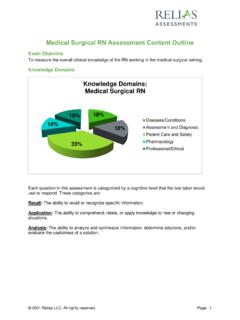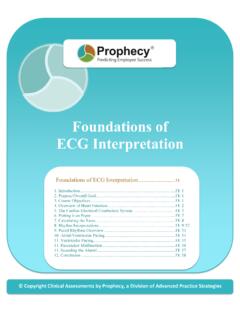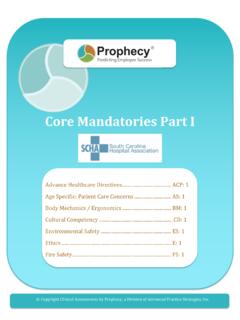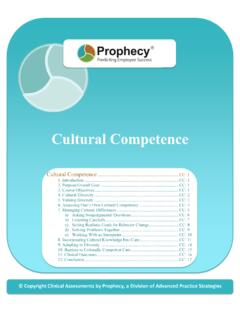Transcription of Emergency Management Preparedness CP - Relias
1 Predicting Employee SuccessPredicting Employee SuccessProphecyProphecy Copyright Clinical Assessments by Prophecy, a Division of Prophecy Healthcare, Inc. Emergency Management Preparedness Emergency Management : 1 1. : 1 2. What Constitutes a Disaster ?..DP: 1 3. CLASS A ..DP: 2 4. CLASS : 2 5. CLASS : 3 6. Emergency Management : 3 7. Joint Commission : 3 8. The HICS : 4 9. Priorities of the Hospital Disaster : 4 10. Communicating the Plan to All : 11 11. Conducting : 11 12. Maintaining the : 12 13. The Importance of Area : 12 14. General Safety Procedures for Common : 12 15. : 16 DP: 1 Copyright Clinical Assessments by Prophecy, a Division of Prophecy Healthcare, Inc.
2 Emergency Management Preparedness Introduction While some disasters are the result of natural events, many more are a result of human error. They usually strike without warning and their effects can be devastating, affecting hundreds, even thousands of lives. For the healthcare environment, disasters are categorized as either internal events that occur within the medical facility or external, which occur outside of the hospital and can be declared by an internal or external authority or can be undeclared. For those responsible for managing patients, visitors and staff during these events, it is clear that without extensive planning and organization, Emergency resources and support services cannot be effectively deployed.
3 Without a good disaster plan in place, time is lost and lives are threatened. A carefully conceived and executed disaster Preparedness plan is an institution s most critical defense in an Emergency . A plan that is developed according to the daily routine of the staff is the MOST successful plan utilized. What Constitutes a Disaster ? According to the World Health Organization, a disaster is a sudden ecological phenomenon of sufficient magnitude to require external assistance. The American College of Emergency Physicians describes a disaster a little differently, stating that a disaster has occurred when the destructive effects of natural or man-made forces overwhelm the ability of a given area or community to meet the demand for healthcare.
4 While there may be different definitions, a disaster by any other name is still a disaster. Nurses and other professionals working in the healthcare environment MUST be prepared to handle disasters and other significant events occurring inside or outside their walls. An external disaster is an event that impacts a facility when demand for services go beyond available resources. An internal disaster is an event that happens within the facility that poses a threat to interrupt the environment of care. Disaster events may be categorized according to type and severity: DP: 2 Copyright Clinical Assessments by Prophecy, a Division of Prophecy Healthcare, Inc.
5 CLASS A Natural Disasters * Earthquakes Floods Tornadoes Hurricanes Blizzards Other serious weather conditions External Disasters / Medical Emergencies * Chemical exposure Epidemic of disease (biological) Explosions Fire Large-scale poisoning Multiple-victim accidents (car, bus, train, plane crashes) Nuclear fallout Riots and other civil disturbances Structural collapse Toxic radiation * Require response by Hospital Disaster Committee CLASS B Internal Disasters / Medical Emergencies * Disease epidemics Large-scale food poisoning Large-scale infections * May require response by Hospital Disaster Committee DP: 3 Copyright Clinical Assessments by Prophecy, a Division of Prophecy Healthcare, Inc.
6 CLASS C Internal Disasters / Non-medical emergencies * Explosions Fire Multi-administrative death Terrorist activity Bomb threats State Board of Health declared Emergency Strikes Union activity Malpractice suit or accusation against hospital or physician on staff Power failure Major mechanical failure Internet- or computer-related issues involving patient records * May require hospital response by Hospital Disaster Committee In this Module Update, we will focus on events as mandated by the Joint Commission. We will present generalized information from the Hospital Incident Command System (HICS), which was developed specifically for medical institutions.
7 Emergency Management Preparation As a healthcare professional, you should know and understand your institution s disaster Preparedness plan, as well as rulings set forth by the Joint Commission and the widely accepted HICS guidelines relating to disaster planning. Joint Commission Standards It is important for you to familiarize yourself with the latest standards, so you will be prepared in case of disaster. Research indicates that hospitals who have assigned leadership of Emergency Management to high-levels of the organization more effectively respond to disaster situations. The Joint Commission recently added new requirements to address those findings.
8 The new elements of performance require the organization to: identify a leader to oversee Emergency Management consider input from staff at different levels when evaluating exercises and responses to events review the organization's Emergency Management plan, performance and responses to actual events by the senior hospital leaders to facilitate improvement DP: 4 Copyright Clinical Assessments by Prophecy, a Division of Prophecy Healthcare, Inc. According to the Joint Commission, an effective Emergency Management plan includes four key principles: Mitigation - Make plans ahead of time to lessen the severity and impact of an Emergency .
9 Preparation - Build needed organizational capacities, including supplies and equipment, agreements with vendors, staff orientation and training, planning processes, and organization-wide drills. Response - Define actions staff would take when confronted by an Emergency , such as reporting to prearranged locations. Plan for a warning and notification process, priority-setting and liaison with other organizations. Recovery - Take steps to restore essential services and resume normal operations - plan for staff support and community response By implementing these four principles, your institution is prepared for any disaster, both man-made and natural.
10 The HICS (Hospital Incident Command System) Plan The HICS Management plan meets Joint Commission standards and offers simplified, predictable Management structure for: communications during disasters predefined Management positions, such as Incident Commander and Section Chiefs clarifies the chain of command and reporting channels helps to improve communication within the facility, as well as other participating facilities provides standardized forms for consistent documentation Priorities of the Hospital Disaster Committee When disaster strikes in the healthcare institution, the Hospital Disaster Committee should be activated. Each member is assigned specific Management duties during and directly following a disaster, as set forth in the facility s Disaster or Emergency Preparedness Plan.











